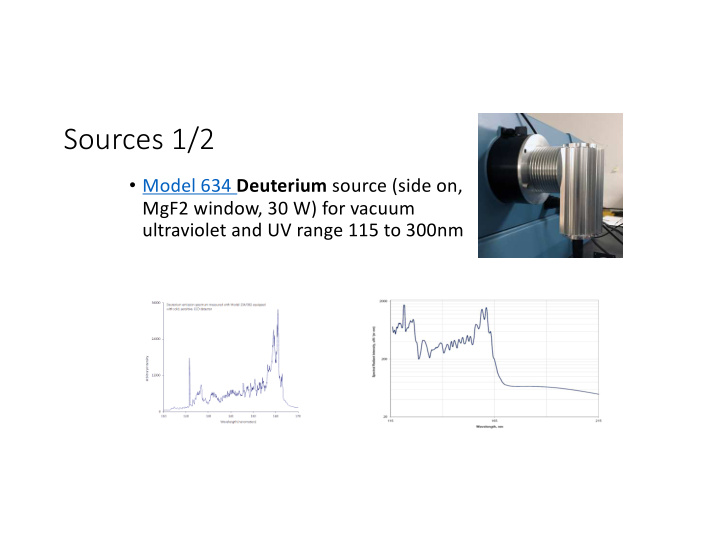



Sources 1/2 • Model 634 Deuterium source (side on, MgF2 window, 30 W) for vacuum ultraviolet and UV range 115 to 300nm
Sources 2/2 • Model 621 universal chimney-type lamp housing with forced air cooling, safety interlock, 150 W Xenon Arc Ozone free w/ rear reflector.
Source coupler • Vacuum energy optimizer with two source branches Xe lamp D2 lamp (250-600 nm) (115-250 nm)
Filter wheel for order sorting Vacuum manual filter wheel with 5-posn, 25mm DIA: Long pass filter for 220nm • Long pass filter for 400nm • Open • Block (for detector background) •
Collimator coupling monochromator to sample chamber • Compact collimating chamber employs aspheric mirrors to produce a collimated beam. Provides 90% of the available Exit slit rays emitted from monochromator at the sample (in Model 121.) Vacuum NW40K ports
Vacuum Sample Chamber • Model 121 Reflectance / Transmission sample chamber • three-sample stage (sample, reference, blank) indexing between 1" samples • Quik-flange type ports (NW100K and three NW40K) • Measure variable angle reflectance at incident angles from <10 – 60 degrees plus transmission (180 degrees.) Freely position sample and detector angle with respect to the incident beam.
Detector 2/2 PHOTOMULTlPLlER TUBES TPMHB0223EA 100 R6094, R6095 CATHODE RADIANT SENSITIVITY CATHODE RADIANT SENSITIVITY (mA / W) 10 28mm(1–1/8 Inch) Diameter, 11–stage, Bialkali Photocathode, QUANTUM EFFICIENCY (%) Head–On Type, Low Dark Current, High Stability,Low Profile (R6094) QUANTUM EFFICIENCY 1 GENERAL Parameter Description/Value Unit Spectral Response 300 to 650 nm Wavelength of Maximum Response 420 nm 0.1 MateriaI Bialkali Photocathode Minimum Effective Area 25 mm dia. Window MateriaI Borosilicate glass Box and Line Structure Dynode Number of Stages 11 0.01 200 400 600 800 Base 14–pin glass base WAVELENGTH (nm) Suitable Socket E678–14C (supplied)
Scintillator for VUV Detection Sodium salicylate is the most popular scintillator we use today. Sodium salicylate has excellent fluorescent efficiency, nearly constant response in the 30 to 300nm spectral region, is easy to prepare, and does not affect vacuum pressure. Stability of fluorescence efficiency is excellent over time in vacuum systems with clean dry vacuum pumps. We have systems in the field using it for more than twenty years with continued good operation. It is our first choice for preparing photomultipliers for spectroscopy in the vacuum ultraviolet. Emission Wavelength: 420nm Decay Time: 7-12 nanoseconds Crystalline layer of approximately 1-2mg/cm 2 Characteristic: Fluorescence Efficiency: ~60% for incident wavelengths 40 to 300nm
115-250 nm
200-360 nm
350-600 nm
Composite ratio Hematite
Lamp drift characterization Ratio of two lamp • spectra, obtained before and after the sample spectrum. Separation in time ~30 • min
Lunar Polarization Volcanic Ash “ per mille ” or “ per thousand ” Mare symbol Moon Highlands Lyot, 1929 1971, Dollfus & Bowell 14
128 Accessible with LASP TREX lab Roughly: 10 – 100deg (exact range TBD) eo 0 Bo 120 160 LBO Angle of vision in degrees A-Mixture of ashes, of 0.13 albedo B -Average curve for the Moon Figure 51. Lunar Ground and Volcanic Ashes area is 0.13. This number represents fairly well the average albedo of the Moon according to the definition employed in the present work (1). The curve B of Fig. 51 is the average of the curvesfor the first quarter and the last quarter A and B is remarkable, of the Moon. The similarity between the curves considering the great dif- ferences that the curves of other materials show. On the other hand, the volcanic ashes scatter back in the direction of the source, even for very high angles of incidence, a proportion of polar- ized light which is smaller than that of all the other substances studied. This proportion never ratio of 1/1000. I have 'exceeds the shown (French page 46) however, that the Moon shows this effect only very faintly. Finally, the lunar ground, when obliquely illuminated, scatters much more light in the direction close to the Sun than in the opposite direction. The same is true of an area covered with dull powders and especially with volcanic ashes. All these similarities lead us to conclude that the Moon must be almost completely covered with powders having a constitution similar to that of the Earth's volcanic ashes. These powders could also be in the form of a very (1) of 0.17, the The value of this quantity is poorly known. Zollner gave the value Annuaire du Bureau des Longitudes gives the value of 0.15, the work entitled Astronomy by Russel, Dugan and Stewart gives for the most probable average value for the brightness of the full Moon a value of 1/465,000 with respect to the Sun (from this ratio a value of 0.110 is found for the albedo).
Vacuum pumpdown curve
Cooled sample holder Liquid Nitrogen cryostat (Janis • VPF-100) Temperature controller with • cable (Lakeshore 325)
Vacuum pump • 300 liter per second air-cooled turbo pump system (Edwards) with adapter from pump to spectrometer, pump PS and controller, oil free scroll roughing pump, metal fore line to connect the two. Included gauge system with digital display and includes integrated controller • Manifold on pump connected to spectrograph cavity and sample chamber (i.e. bypassing exit slit)
Lunar polarization 1970, Coyne & Pellicori Coyne GV, Pellicori SF (1970) Wavelength dependence of polarization. xx. the integrated disk of the moon. Astron J. 75:54-60. doi:10.1086/110940
Polarization vs wavelength 0.25 WUPPE (not full disk) [8] waning waxing 0.20 SOLSTICE polarization 0.15 Coyne & Pellicori [7] 0.10 0.05 60° phase 0.00 200 300 400 500 wavelength (nm) Fox et al, 1998, WUPPE, MNRAS 298 Coyne & Pellicori, 1970, Astron. J. 75 21
Recommend
More recommend